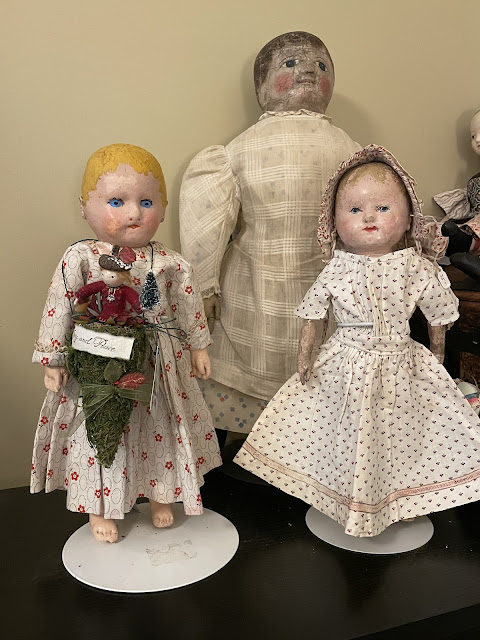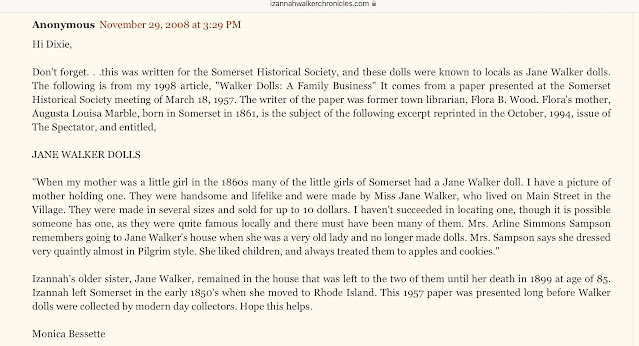As I've been updating the pictorial directory on this site, I'm studying certain dolls intently. Some dolls appear at auction and some time later in other venues, having been changed. This is a statement of fact, not judgement. Sometimes dolls have had some tiny conservation/repainting done to replace lost paint, sometimes they have been totally repainted, and sometimes they have had old repaint completely removed. It's fascinating to see.
A doll collector who is a purist will say LEAVE that doll alone, no matter what. Let them wear their story to this point. When I was giving a talk on Izannah Walker dolls via Zoom I revealed the prosthetic arm I made for my Izannah Walker doll who is missing an arm. This is attached to a band worn over the shoulder of the doll and NOT sewn TO the doll in any way. A collector listening held up her Izannah Walker doll which was missing some parts and said, "I left it alone."
Sometimes a doll comes across your path and you know it needs to better reflect the intent of the original maker. A case in point is this 13" Martha Chase doll on the left in the picture below, which I bought along with the other Martha Chase doll of the same size. The water-based overpaint on her limbs is cracking and peeling off. That's what happens when water-based paint covers oils. Her repainted eyes say, "I've seen things." I don't want that to be her story. Until I decide what to do with her, I gave her a little "Joy and Peace" companion doll made by Peggy Flavin. The big doll Zelda watches over, telling her "every little thing's gonna be alright"!
Many antique dolls have been repaired and/or repainted at home, long ago by a family member. Sometimes children's dolls were sent off to "doll hospitals" to be fixed, such as the Martha Chase Doll Factory. At that time an Izannah Walker doll was merely an old doll in need of repair, not an example of folk art to be preserved. Sometimes the repaint is so old it doesn't register with a blacklight.
Izannah designed her dolls for play. She wanted to make an "everlasting doll" but her point for doing so was pragmatic. Her goal was that a child could actually PLAY with her doll and not be harmed by it when playing with it, per her patent. An advertisement discovered by Kathy Duncan show Izannah's dolls were being marketed for play and being forgotten! The ad copy says,
"their chief merit consisting in their ability to stand rough usage and abandonment serenely"
Izannah's dolls were not to be placed on a high shelf to only be used for an hour on Sunday. The dolls were designed to travel through life with the child. And they did! Many an Izannah Walker doll has lost body parts while their owners danced with them. They are prone to breaks at the ankles, and sometimes the arms, from being carried by a child.
This is the case with the doll that I, Dixie, own. She's missing an arm, and a foot. Her body covering is in tatters. I named her Hope. Someone felt this doll was important enough to be stabilized, having stitched the torn stockinette on the head down in a somewhat awkward way. Aside from the prosthetic arm, I have not changed this doll at all. She is in "original" condition, although very, very worn. If she were to continue on her journey, someone might decide to conserve her and give her better paint, a new nose, a new body covering, etc.
Collectors of Izannah Walker dolls face a decision point when they purchase a doll. How best to preserve the original design of the doll, and also stabilize and conserve these examples of folk art for the future? Sometimes the answer is "leave it alone". Sometimes the answer is "there's an Izannah under there" and filler and repaint needs to be removed.
Before doing anything, here are some questions to consider:
Who should do repairs?
Repairs should be done by someone who has studied Izannah's dolls extensively, is an artist with many years of experience with oil paints, and has years of study of antique textiles.
Other questions to consider:
What feels original and should be left alone?
What mutes the original design and should be removed?
Will the doll be better off if nothing is done?
If nothing is done, does it expose the doll to ongoing additional damage?
Will the changes made be removable?
Will changes made disrupt original parts of the doll's paint?
I'm sure readers can supply more questions and thoughts. This is just the tip of the iceberg.
The next post will document an Izannah Walker doll which was conserved by its owner, an expert in antique textiles, a doll collector of 50+ years, and an artist of many decades.









